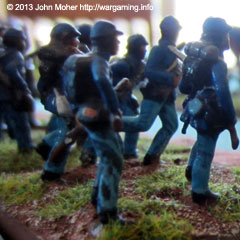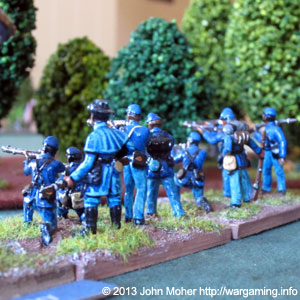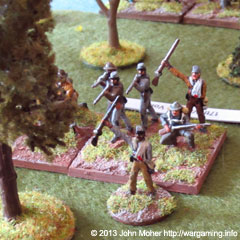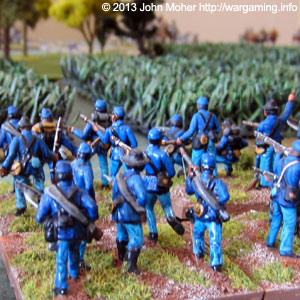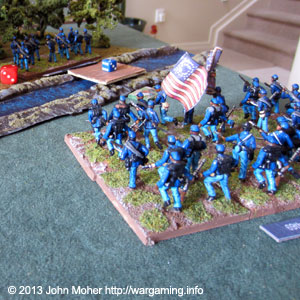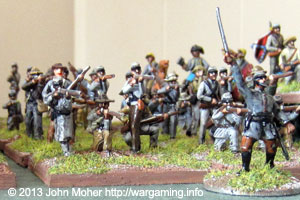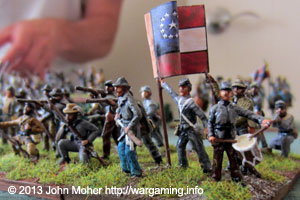Following on from our action on the Gettysburg-Hanover railroad, a major action was fought by the Army of the Potomac against General Lee’s Army of Northern Virginia – this epic 3 day encounter was thought to have decided the war, but as usual the Confederates managed to slip away from us and retire to the safety of Virginia with our pursuit proving cumbersome and erratic. The outstanding performance of our new commander (General Meade) at Gettysburg was somewhat tarred by the escape of Lee and ‘his boys’ and we spent the next two months playing a very ponderous game of cat and mouse around Northern Virginia! However good news had come from the west, at the same as we were at Gettysburg, my namesake General ‘Ulysses’ S. Grant had defeated the rebs at Vicksburg, and finally wrestled control of the mighty Mississippi – the Confederacy was cut in two. Shortly after General Grant was promoted to command of all the U.S. armies and headed east to join us, basing himself with the Army of the Potomac.
Tag: Mississippi
Marching On Richmond: Pennsylvania 1863
A few weeks after our defeat at Chancellorsville, as we were reorganising my division as previously described, General Robert E. lee suddenly invaded the north again, this time heading for Pennsylvania! By the time our army was aware of his manoeuvre he had a sizeable head start, but we hurried after him with much greater vigour than previous occasions, heading through Maryland into the heart of Pennsylvania. As we neared the end of June our commander (Joe Hooker) was replaced by yet another new commander, General George Meade was now head of the Army of the Potomac. However meanwhile, unknown to us, General J.E.B. Stuart had taken his cavalry off on a wild raid deep into our territory, effectively leaving the main CSA army blind, and as a result we blundered into him in late June catching up on part of one of his corps, and forcing on them a hasty defensive battle. We were several miles north of a town called Gettysburg, along the Gettysburg-Hanover railroad, and the date was the 30 June 1863.
Marching On Richmond: May 1863
Following our army’s defeat at Chancellorsville and our withdrawal back across the Rappahannock we again had a period of some inactivity, during which we reorganised our forces and received further replacements. My Division were in fairly good spirits (as we had been victorious at the Cornfields), but we had a large number of men who had succumbed to injury, wounds, or illness during the previous campaign, and despite the Summer weather attrition had taken it’s toll. However we had also heard the enemy had suffered a great leadership loss, the great Stonewall Jackson had apparently been shot by his own men (a sad end to a great warrior). It was at this juncture, and in anticipation of a new summer campaign in the coming weeks, that I took the difficult decision of merging some of my regiments, their numbers having fallen to only that of the strength of 1-2 companies, and therefore their combat effectiveness was becoming questionable. To try and reduce the resentment this would cause the regiments that were broken up were sent as replacements to their closest ‘neighbouring’ regiments – in the hope this would smooth the transition.
Marching On Richmond: The Cornfields 1863
After our breaking from winter quarters we began a march once more into Virginia, tasked with joining the balance of the army of the Potomac that had wintered in the vicinity of Fredericksburg, and was now under the command of Maj. Gen. Joseph Hooker. By late April the army was fully assembled and our new commander was preparing to launch his grand offensive, which you will of course now know dear reader culminates in the great battle of Chancellorsville, and we were to be in the vanguard. Setting forth on the last days of April we had crossed the Rappahannock and now pushed our columns forward through the wilderness and outlying Confederate Pickets, and headed South-East, towards the open farmland in the rear of General Lee’s army at Fredericksburg. Sporadic actions developed over these days but it was on the 1 May 1863 that the first serious clashes occurred, and we were involved…
Continue reading “Marching On Richmond: The Cornfields 1863”
Marching On Richmond: Winter 1862
Our action near the Antietam Creek had been disappointing, and we ended up going into winter camp with the gloom of mediocrity over us. However the cheery news was our whole army had given Robert E. Lee a very bloody nose in the greater action – and we soon cheered at the thought of finally ending this whole affair in the coming summer – 1863 would be the year the Union was reconstituted! meanwhile we continue to hear continual news of our nemesis, Brigadier General Longman, through the rumour mill – again his name seems splashed all over the Rebel papers with tales of great daring, while alas there is no such joy for me.
Marching On Richmond: Fall 1862
Having set forth into Maryland in pursuit of General Robert E. Lee we headed North-West as part of the great Union Army, a mighty force of 80,000 or more men that surely would finally end this break in the Union, and restore the country. After two weeks rapid marching through the hills and mountains we came upon the main rebel army, and as our forces converged I was tasked with holding a vital section of river, to ensure the enemy could not use it as a route to slip out of our trap!
During our march rebel cavaliers had been harrying some of our supply columns, cutting or intercepting our telegraph lines, and generally making a nuisance of themselves. As a result as my small Division deployed to its allotted flank guard position I was conscious of the possible presence of enemy raiders in my rear – having no cavalry in my command I had no means either to effectively monitor for their presence.
Marching On Richmond: Late Summer 1862
Following on from our victory at Seven Pines, and the army’s less successful actions in the Seven Days campaign, as mentioned we were then surprisingly withdrawn from the Virginia Peninsula and brought back to Maryland. During this period we received very few reinforcements and had also suffered somewhat from the summer scourge of mosquitoes and other nasties. However before departing the peninsula we had managed to reform the remnants of the 12th New York, although we left behind several of our force.
